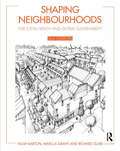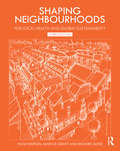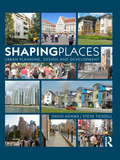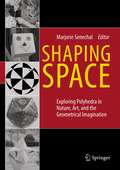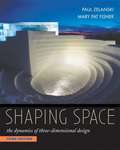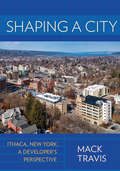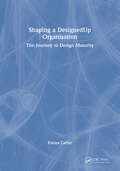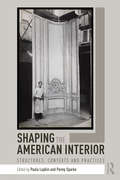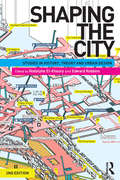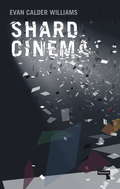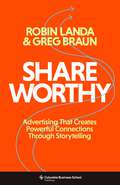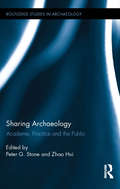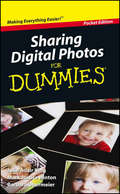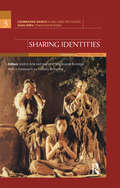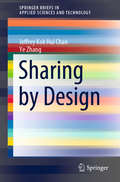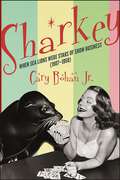- Table View
- List View
Shaping Neighbourhoods: For Local Health and Global Sustainability
by Hugh Barton Marcus Grant Richard GuiseThis substantially revised and important second edition comes at a pivotal time, with both a strong agenda of localism in planning and with public health professionals now realising the vital importance of shaping urban environments in order to reduce the burden of disease and support better health outcomes. This guide ensures you: understand the underlying principles for planning healthy and sustainable neighbourhoods and towns plan the collaborative and inclusive processes needed for multi-sectoral cooperation develop know-how and skills in matching local need with urban form discover new ways to integrate development with natural systems design places with character and recognise good urban form guide communities, and advise developers, in the creation of successful and sustainable places for living. Containing many new case studies and a wealth of new research, this new edition has benefited from previous user feedback. Shaping Neighbourhoods is the indispensable guide for bridging the gulf between theory and practice, between planning authorities, investors and communities, and between different professional perspectives. Whether you are a student faced with a local planning project; a planner, urban designer or developer involved in new development; a health authority concerned with promoting physical activity; or a community group wanting to improve your neighbourhood; this book is for you.
Shaping Neighbourhoods: For Local Health and Global Sustainability
by Hugh Barton Marcus Grant Richard GuiseShaping Neighbourhoods is unique in combining all aspects of the spatial planning of neighbourhoods and towns whilst emphasising positive outcomes for people’s health and global sustainability. This new edition retains the combination of radicalism, evidence-based advice and pragmatism that made earlier editions so popular. This updated edition strengthens guidance in relation to climate change and biodiversity, tackling crises of population health that are pushing up health-care budgets, but have elements of their origins in poor place spatial planning – such as isolation, lack of everyday physical activity, and respiratory problems. It is underpinned by new research into how people use their localities, and the best way to achieve inclusive, healthy, low-carbon settlements. The guide can assist with: • Understanding the principles for planning healthy and sustainable neighbourhoods and towns • Planning collaborative and inclusive processes for multi-sectoral working • Developing know-how and skills in matching local need with urban form • Discovering new ways to integrate development with natural systems • Designing places with character and recognising good urban form Whether you are a student faced with a local planning project; a public health professional, planner, urban designer or developer involved in new development or regeneration; a council concerned with promoting healthy and sustainable environments; or a community group wanting to improve your neighbourhood – you will find help here.
Shaping Places: Urban Planning, Design and Development
by David Adams Steve TiesdellShaping Places explains how towns and cities can turn real estate development to their advantage to create the kind of places where people want to live, work, relax and invest. It contends that the production of quality places which enhance economic prosperity, social cohesion and environmental sustainability require a transformation of market outcomes. The core of the book explores why this is essential, and how it can be delivered, by linking a clear vision for the future with the necessary means to achieve it. Crucially, the book argues that public authorities should seek to shape, regulate and stimulate real estate development so that developers, landowners and funders see real benefit in creating better places. Key to this is seeing planners as market actors, whose potential to shape the built environment depends on their capacity to understand and transform the embedded attitudes and practices of other market actors. This requires planners to be skilled in understanding the political economy of real estate development and successful in changing its outcomes through smart intervention. Drawing on a strong theoretical framework, the book reveals how the future of places will come to be shaped through constant interaction between State and market power. Filled with international examples, essential case studies, color diagrams and photographs, this is essential reading for undergraduate and graduate students taking planning, property, real estate or urban design courses as well as for social science students more widely who wish to know how the shaping of place really occurs.
Shaping Portland: Anatomy of a Healthy City
by Paddy TillettPortland is a young city founded on a river bank in a virgin forest less than 200 years ago. Shaping Portland: Anatomy of a Healthy City is about the values engendered by the place, and how those values have influenced the growing city. It examines how and why the public realm supports or obstructs the health-forward lifestyles of those who choose to live there. This book explores the values and dynamics that shaped a healthy city to enable those things. It is a case study of a recognized success – looking more closely at a recent urban infill: the Pearl District. The future roles of the planners and other design professionals in continuing to build healthy and responsive environments are suggested. The cities of the future will be those that we already inhabit, but infilled and adapted to tomorrow’s needs and values. Understanding the dynamics involved is essential for those in whose hands we entrust the design of cities and urban places.
Shaping Space
by Marjorie SenechalThis second edition is based off of the very popular Shaping Space: A Polyhedral Approach, first published twenty years ago. The book is expanded and updated to include new developments, including the revolutions in visualization and model-making that the computer has wrought. Shaping Space is an exuberant, richly-illustrated, interdisciplinary guide to three-dimensional forms, focusing on the suprisingly diverse world of polyhedra. Geometry comes alive in Shaping Space, as a remarkable range of geometric ideas is explored and its centrality in our cultre is persuasively demonstrated. The book is addressed to designers, artists, architects, engineers, chemists, computer scientists, mathematicians, bioscientists, crystallographers, earth scientists, and teachers at all levels--in short, to all scholars and educators interested in, and working with, two- and three-dimensinal structures and patterns.
Shaping Space The Dynamics of Three-Dimensional Design 3rd Edition
by Mary Pat Fisher Paul ZelanskiThis book offers an engaging, in-depth exploration of the aesthetic and practical considerations of working three-dimensionally. It also includes new and expanded coverage of kinetic art, ephemeral and conceptual work, and works incorporating video and sound.
Shaping a City: Ithaca, New York, a Developer's Perspective
by Mack TravisPicture your downtown vacant, boarded up, while the malls surrounding your city are thriving. What would you do?In 1974 the politicians, merchants, community leaders, and business and property owners, of Ithaca, New York, joined together to transform main street into a pedestrian mall. Cornell University began an Industrial Research Park to keep and attract jobs. Developers began renovating run-down housing. City Planners crafted a long-range plan utilizing State legislation permitting a Business Improvement District (BID), with taxing authority to raise up to 20 percent of the City tax rate focused on downtown redevelopment.Shaping a City is the behind-the-scenes story of one developer’s involvement, from first buying and renovating small houses, gradually expanding his thinking and projects to include a recognition of the interdependence of the entire city—jobs, infrastructure, retail, housing, industry, taxation, banking and City Planning. It is the story of how he, along with other local developers transformed a quiet, economically challenged upstate New York town into one that is recognized nationally as among the best small cities in the country.The lessons and principles of personal relationships, cooperation and collaboration, the importance of density, and the power of a Business Improvement District to catalyze change, are ones you can take home for the development and revitalization of your city.
Shaping a DesignedUp Organisation: The Journey to Design Maturity
by Emma Carter“Emma Carter reveals how organizations can shift from tech-centric to design-led, creating meaningful experiences. Through case studies and practical frameworks, she demonstrates how scaling design isn’t about adding more designers but transforming how organizations think and operate. This essential guide helps leaders embed design thinking at every level, turning transformation into a continuous evolution.In Shaping a DesignedUp Organisation Emma Carter distills the essence of digital transformation: true progress lies in simplifying through design thinking, not adding complexity. Like a conductor harmonizing an orchestra, she shows how tech and design can work together to serve human needs. More than a book on shaping and scaling design, this is a vision for a more powerful, humane digital future—essential for those bridging technology and human experience.”—John Maeda, VP Engineering, Head of Computational Design / AI Platform, MicrosoftThe learnings gained from Shaping a DesignedUp Organisation will not only give design leaders a seat at the table, it’ll make them the smartest person at the table - creating influence, driving conversations for growth, and ultimately shaping their company into a ‘design mature’ organisation.But that’s not to say this book is strictly for design leaders. Tech leaders, product leaders and business leaders will come to see how business performance and design are intrinsically linked. You’ll gain intimate insights from leaders at world-leading organisations like Spotify, Disney, Airbnb, Monzo and frog and learn about a variety of frameworks and practical approaches to help your organisation reach design maturity with a human focus.And if you’re in an organisation not convinced by the value of design, you’ll learn how to translate the benefits of embedding design at every touchpoint in a way that’s meaningful, valuable and profitable to various stakeholders, creating an army of design advocates to future proof your organisation…and decrease its risk of becoming a dinosaur.
Shaping the American Interior: Structures, Contexts and Practices
by Penny Sparke Paula LupkinBringing together 12 original essays, Shaping the American Interior maps out, for the first time, the development and definition of the field of interiors in the United States in the period from 1870 until 1960. Its interdisciplinary approach encompasses a broad range of people, contexts, and practices, revealing the design of the interior as a collaborative modern enterprise comprising art, design, manufacture, commerce, and identity construction. Rooted in the expansion of mass production and consumption in the last years of the nineteenth century, new and diverse structures came to define the field and provide formal and informal contexts for design work. Intertwined with, but distinct from, architecture and merchandising, interiors encompassed a diffuse range of individuals, institutions, and organizations engaged in the definition of identity, the development of expertise, and the promotion of consumption. This volume investigates the fluid pre-history of the American profession of interior design, charting attempts to commoditize taste, shape modern conceptions of gender and professionalism, define expertise and authority through principles and standards, marry art with industry and commerce, and shape mass culture in the United States.
Shaping the City: Studies in History, Theory and Urban Design
by Rodolphe El-Khoury Edward RobbinsTaking on the key issues in urban design, Shaping the City examines the critical ideas that have driven these themes and debates through a study of particular cities at important periods in their development. As well as retaining crucial discussions about cities such as Los Angeles, Atlanta, Chicago, Detroit, Philadelphia, and Brasilia at particular moments in their history that exemplified the problems and themes at hand like the mega-city, the post-colonial city and New Urbanism, in this new edition the editors have introduced new case studies critical to any study of contemporary urbanism – China, Dubai, Tijuana and the wider issues of informal cities in the Global South. The book serves as both a textbook for classes in urban design, planning and theory and is also attractive to the increasing interest in urbanism by scholars in other fields. Shaping the City provides an essential overview of the range and variety of urbanisms and urban issues that are critical to an understanding of contemporary urbanism.
Shaping the Landscape: Celebrating Dance in Australia (Celebrating Dance in Asia and the Pacific)
by Stephanie Burridge; Julie DysonThis, the fourth book in the series 'Celebrating Dance in Asia and the Pacific', explores the current dance scene in Australia from a wide perspective that mirrors the creative engagement of artists with Australian culture and the landscape. It looks at Indigenous dance, choreography beyond theatre, youth and community dance, Australian dancers’ versatility and risk-taking. The comprehensive essays recount immigrant influences, the legacy of the Ballets Russes and Bodenwieser companies, dance on stage and screen, education and training and the story of Ausdance — the unique nation-wide voice and political advocacy organisation for dance.
Shapleigh and Acton (Images of America)
by Debbie PetersenIncorporated in 1785, Shapleigh and Acton once comprised a single town covering approximately 32,000 acres. Due to the several large lakes at its center, the land was divided into east and west parishes. After much controversy and disagreement, the west parish was incorporated as the Town of Acton in 1830. With its abundant timber, fertile farmland, and extensive bodies of water, the area grew quickly and prospered. Today many local farmers work the same land and live in the same homes as their forefathers. Each summer, countless families throughout New England migrate to the numerous lakes that lie within the Shapleigh and Acton area, and motorists enjoy the the area's rolling hills, stone walls, picturesque mountains, and sparkling lake views. Nestled between the rocky Maine coastline and the White Mountains of New Hampshire, Shapleigh and Acton are charming, historic towns that capture the spirit of Maine and "The Way Life Should Be."
Shard Cinema
by Evan Calder WilliamsShard Cinema tells an expansive story of how moving images have changed in the last three decades and how they changed us along with them, rewiring the ways we watch, fight, and navigate an unsteady world. With a range that spans film, games, software, architecture, and military technologies, the book crosses the twentieth century into our present to confront a new order of seeing and making that took slow shape: the composite image, where no clean distinction can be made between production and post-production, filmed and animated, material and digital. Giving equal ground to costly blockbusters and shaky riot footage, Williams leads us from computer-generated “shards” of particles and debris to the broken phone screen on which we watch those digital storms, looking for the unexpected histories lived in the interval between.
Shared Encounters
by Katharine S. Willis Konstantinos Chorianopoulos Mirjam Struppek George RoussosEvery day we share encounters with others as we inhabit the space around us. In offering insights and knowledge on this increasingly important topic, this book introduces a range of empirical and theoretical approaches to the study of shared encounters. It highlights the multifaceted nature of collective experience and provides a deeper understanding of the nature and value of shared encounters in everyday life. Divided into four sections, each section comprises a set of chapters on a different topic and is introduced by a key author in the field who provides an overview of the content. The book itself is introduced by Paul Dourish, who sets the theme of shared encounters in the context of technological and social change over the last fifteen years. The four sections that follow consider the characteristics of shared encounters and describe how they can be supported in different settings: the first section, introduced by Barry Brown, looks at shared experiences. George Roussos, in the second section, presents playful encounters. Malcolm McCulloch introduces the section on spatial settings and - last but not least - Elizabeth Churchill previews the topic of social glue. The individual chapters that accompany each part offer particular perspectives on the main topic and provide detailed insights from the author's own research background. A valuable reference for anyone designing ubiquitous media, mobile social software and LBS applications, this volume will also be useful to researchers, students and practitioners in fields ranging from computer science to urban studies.
Shareworthy: Advertising That Creates Powerful Connections Through Storytelling
by Robin Landa Greg BraunIn today’s highly competitive marketplace, a brand must tell meaningful stories that resonate with their target audiences across media channels. People want more than a utilitarian benefit—stories are ultimately what drive us to engage with brands. And we want to align ourselves with brands that are ethical and purpose-driven and that take responsibility for their actions and messaging.This indispensable book reveals what makes brand stories “shareworthy” and guides readers through creating relevant and resonant advertising. Combining practitioner and academic perspectives, Robin Landa and Greg Braun offer a roadmap for conceiving and developing creative advertising campaigns that are responsible and inclusive—and that audiences enthusiastically share. They demonstrate that shareworthy storytelling embraces diversity, equity, inclusion, purpose, and brand activism and eschews tropes, stereotypes, and negative messaging. The book features candid interviews with expert practitioners spanning diverse global communities who share the hard-earned wisdom of their award-winning campaigns, as well as insightful case studies from major companies such as Amazon, Nike, the New York Times, and Dove. Timely and actionable, Shareworthy shows current and aspiring marketing professionals how to craft a story, connect with the audience, and embrace social responsibility throughout.
Sharing Archaeology: Academe, Practice and the Public (Routledge Studies in Archaeology)
by Peter G. Stone Zhao HuiAs a discipline, Archaeology has developed rapidly over the last half-century. The increase in so-called ‘public archaeology,’ with its wide range of television programming, community projects, newspaper articles, and enhanced site-based interpretation has taken archaeology from a closed academic discipline of interest to a tiny minority to a topic of increasing interest to the general public. This book explores how archaeologists share information – with specialists from other disciplines working within archaeology, other archaeologists, and a range of non-specialist groups. It emphasises that to adequately address contemporary levels of interest in their subject, archaeologists must work alongside and trust experts with an array of different skills and specializations. Drawing on case studies from eleven countries, Sharing Archaeology explores a wide range of issues raised as the result of archaeologists’ communication both within and outside the discipline. Examining best practice with wider implications and uses beyond the specified case studies, the chapters in this book raise questions as well as answers, provoking a critical evaluation of how best to interact with varied audiences and enhance sharing of archaeology.
Sharing Digital Photos For Dummies, Pocket Edition
by Julie Adair King Barbara Obermeier Mark Justice HintonShare your favorite digital photos with family and friends Do you have a collection of great vacation shots just waiting to impress your friends? Or critical photos you must get to yourbusiness associates? This book shows you all the differentoptions for sharing your photos with a few or a lot of people — quickly, easily, and even for free! Open the book and find: Tips for e-mailing photos Insights on posting to photo-sharing sites and blogs Steps for getting the best results from a scanner How to create a photo slide show or video Digital picture frame advice
Sharing Identities: Celebrating Dance in Malaysia (Celebrating Dance In Asia And The Pacific Ser.)
by Mohd Anis Md NorThis anthology celebrates dancing diversities in Malaysia, a multicultural nation with old and not-so-old dance traditions in a synchronicity of history, creativity, inventions and representation of its people, culture and traditions. These articles and interviews document the legacy of dances from the Malay Sultanates to a contemporary remix of old and new dances aspired by a mélange of influences from the old world of India, China, European and indigenous dance traditions. This gives forth dance cultures that vibrate with multicultural dance experiences. Narratives of eclecticism, syncretic and innovative dance forms and styles reflect the processes of inventing and sharing of dance identities from the era of the colonial Malay states to post-independence Malaysia.
Sharing Mobilities: New Perspectives for the Mobile Risk Society (Networked Urban Mobilities Series)
by Dennis Zuev Sven Kesselring Malene Freudendal-PedersenSharing Mobilities focuses on the emergence of future sustainable and collaborative mobility cultures. At the intersection of physical and virtual capacity and access to people, goods, ideas, and services, this book poses fundamental challenges and opportunities for governance, economy, planning, and identity. The future of new collaborative forms of consumption and sharing would play a key role in the organization of everyday life and business. Sharing mobilities is more than simply sharing transport, and its diverse impacts on society and the environment demand thorough theory-led sociological research. With an extensive global range, the contributors present radical manifestations of sharing capacities throughout diverse countries, including Germany, Denmark, Japan, and Vietnam. The phenomenon of mobility is highly actual and social as well as politically relevant and urging. This collection focuses on open questions from the perspective of the mobilities turn while presenting state-of-the-art theory-based articles with applied perspectives. An ideal read for scholars based in social science and the interdisciplinary research on mobility, transports, and sharing economy. Sociologists, geographers, economists, urban governance researchers, and research students would also find this book of interest.
Sharing Stitches: Exchanging Fabric and Inspiration to Sew One-of-a-Kind Projects
by Chrissie GraceSwap, Stitch and Share Exchange fabrics, collaborate on an art quilt and gain inspiration with Sharing Stitches. Chrissie Grace is joined by 15 contributing artists with a wide variety of talents and styles. The result is a collection of colorful and eclectic projects, from a patchwork pullover and a lace-embellished headband to a large-scale collaborative art quilt and a round robin journal. Stitch by stitch, Chrissie shows you how create fantastic projects that are as unique as the group that sews them. Inside Sharing Stitches, you'll find: 22 step-by-step projects designed specifically for swaps and collaborations Tips on swapping fabric, hosting and participating in collaborations, and making sure sewing groups run smoothly Projects and gallery pieces from your favorite artists, including Claudine Hellmuth, Liz Lamoreux, Ruth Rae and more! Break out your sewing machine, round up your friends and start sewing!
Sharing by Design (SpringerBriefs in Applied Sciences and Technology)
by Jeffrey Kok Chan Ye ZhangThis book answers the question of how to design a sharing system that can promote sustained, meaningful, and socially constructive sharing practices in today’s cities. To do so, it constructs a framework for practical inquiry into the design of sharing systems. Further, the book invites readers to consider questions such as: If sharing can be designed, then how does one design a sharing system for cities? Which urban conditions make this sharing system possible? What are the considerations, variables, and methods that can inform and guide the designers of a sharing system? By considering both the environmental and societal motivations for sharing, and the reality that most examples of the Sharing Economy are neither equitable in their socio-economic outcomes nor genuine in their original social promises, this book presents balanced and thoughtful answers to the questions posed above. The book will appeal to a broad readership, from students and teachers in the various design disciplines, to professionals and scholars in architecture and urbanism, business and innovation, and other related fields of the humanities and social sciences, as well as activists and policymakers committed to achieving more sustainable and equitably distributed access to urban resources.
Sharing the Past: The Reinvention of History in Canadian Poetry since 1960
by J.A. WeingartenSharing the Past is an unprecedentedly detailed account of the intertwining discourses of Canadian history and creative literature. When social history emerged as its own field of study in the 1960s, it promised new stories that would bring readers away from the elite writing of academics and closer to the everyday experiences of people. Yet, the academy’s continued emphasis on professional distance and objectivity made it difficult for historians to connect with the experiences of those about whom they wrote, and those same emphases made it all but impossible for non-academic experts to be institutionally recognized as historians. Drawing on interviews and new archival materials to construct a history of Canadian poetry written since 1960, Sharing the Past argues that the project of social history has achieved its fullest expression in lyric poetry, a genre in which personal experiences anchor history. Developing this genre since 1960, Canadian poets have provided an inclusive model for a truly social history that indiscriminately shares the right to speak authoritatively of the past.
Shark Girl
by Kelly BinghamA teenager struggles through physical loss to the start of acceptance in an absorbing, artful novel at once honest and insightful, wrenching and redemptive. On a sunny day in June, at the beach with her mom and brother, fifteen-year-old Jane Arrowood went for a swim. And then everything--absolutely everything--changed. Now she's counting down the days until she returns to school with her fake arm, where she knows kids will whisper, "That's her--that's Shark Girl," as she passes. In the meantime there are only questions: Why did this happen? Why her? What about her art? What about her life? In this striking first novel, Kelly Bingham uses poems, letters, telephone conversations, and newspaper clippings to look unflinchingly at what it's like to lose part of yourself - and to summon the courage it takes to find yourself again.
Shark: A Visual History
by Richard Ellis“The sharks, ancient or modern, real or imaginary, have always been with us, and will probably remain with us forever. They appear not only in movies and literature, but in countless permutations of size, shape, and materials, permeating our daily lives with their silent menace. In a sense, humans live in a world replete with sharks, not vice-versa.” Thus Richard Ellis sets about chronicling and debunking the myths of sharks throughout history. From 18th century art to the phenomena of JAWS, “the shark” has remained the indomitable aggressor of the deep, the last demon of humankind. The image of the shark and the fear it inspires infiltrates our daily lives with its mythical power and strength. But it is not man who should fear the shark. Our need to dominate these predators is destroying them and their habitat. Through hundreds of full-color images Ellis proves the necessity of preserving these majestic creatures. As curator of the Ft. Lauderdale Museum of Art’s exhibition entitled “Shark”, debuting May 2012, Ellis adeptly turns these sleek, efficient hunters from monsters of the deep into rare, beautiful forces of nature.
Sharkey: When Sea Lions Were Stars of Show Business (1907-1958) (Excelsior Editions)
by Gary BohanGold Winner for the 2022 Foreword INDIES Book of the Year Award in the Performing Arts & Music Category"Sharkey is the natural artist, performing his magic for nothing but love." — Wolcott Gibbs, the New YorkerSharkey tells the compelling story of an unusually gifted, trained sea lion who shared the stage with practically every important performer of the first half of the twentieth century—from Bob Hope to Ella Fitzgerald, from Broadway to Hollywood and beyond. Readers follow Sharkey and his flippered colleagues as they travel the world with stops at the Ringling Bros. and Barnum & Bailey Circus, vaudeville houses, Manhattan during the Harlem Renaissance, burlesque nightclubs, movie palaces, Radio City Music Hall, and the legendary studios of early radio, movies, and television, meeting a who's who of showbiz entertainers, sports superstars, and even a US president. Meticulously researched and lavishly illustrated, Sharkey is a quirky slice of New York and entertainment history sure to delight fans of vintage pop culture and Americana, as well as animal lovers.
